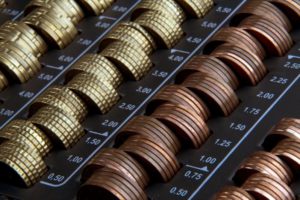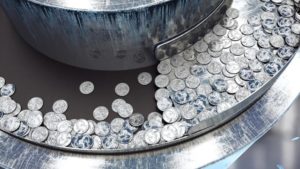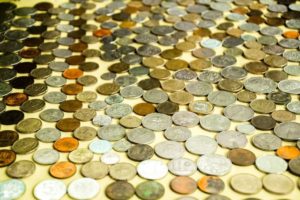Sort it Out!
This lesson focuses on the engineering behind industrial sorting processes. Students work in teams to design and build a system to sort different sized coins for packaging.
- Learn about engineering system.
- Learn about coin manufacturing processes.
- Learn about teamwork and working in groups.
Age Levels: 8-18
Build Materials (For each team)
Required Materials (Table of Possibilities)
- Glue
- Tape
- Paper or plastic plates
- Cardboard
- Scissors or hole punch
- Foil
- Cardboard tubes (paper towel or toilet paper)
- Wood pieces (optional)
Testing Materials
- Bag of coins of different sizes (10 of each)
- Collection device (paper cup, small box, plastic bag, paper bag)
Materials
- Bag of coins of different sizes
- Collection device (paper cup, small box, plastic bag, paper bag)
Process
The teams’ systems are tested by having the teacher move from system to system and inserting 10 of each coin. Students should explain how their systems work so that it is clear how and where the coins should be put in.
Teams record how many coins are correctly sorted into separate containers (boxes, bags, cups).
Design Challenge
You are a team of engineers working in a mint who have been given the challenge of developing a sorting system for different coins manufactured at your facility.
Criteria
- Must sort coins of different sizes into a collection container.
Constraints
- Use only the materials provided.
- Teams may trade unlimited materials.
- Break class into teams of 2-3.
- Hand out the Sort it Out worksheet, as well as some sheets of paper for sketching designs. If possible, provide students time to visit the websites of various mints worldwide, and in particular the virtual tour of the U.S. Mint.
- Discuss the topics in the Background Concepts Section.
- Review the Engineering Design Process, Design Challenge, Criteria, Constraints and Materials.
- Provide each team with their materials.
- Explain that students must develop a system for sorting different coins.
- Announce the amount of time they have to design and build (1 hour recommended).
- Use a timer or an on-line stopwatch (count down feature) to ensure you keep on time. (www.online-stopwatch.com/full-screen-stopwatch). Give students regular “time checks” so they stay on task. If they are struggling, ask questions that will lead them to a solution quicker.
- Students meet and develop a plan for their sorter. They agree on materials they will need, write/draw their plan, and present their plan to the class. Teams may trade unlimited materials with other teams to develop their ideal parts list.
- Teams build their designs.
- The teams’ systems are tested by having the teacher move from system to system and inserting 10 of each coin. Students should explain how their systems work so that it is clear how and where the coins should be put in. Teams record how many coins are correctly sorted into separate containers (boxes, bags, cups).
- As a class, discuss the student reflection questions.
- For more content on the topic, see the “Digging Deeper” section.
Tips
There are many ways to sort the coins. It’s best to let the students come up with their own solutions which will also expose them to the processes of negotiation and teamwork – – all of which are part of the everyday life of an engineer.
A ramp may be used with holes just a bit larger than each coin cut into a cardboard or wood base — the smaller holes are at the top so that the smaller coins are sorted out first. In this method, the angle of the ramp will determine if the coins move down at a slow enough speed to be caught in the holes (too close to vertical will cause the coins to move too fast to be caught in the holes; too horizontal a slope will cause the coins to get caught and not move down).
Another method is using gravity by setting up a series of hanging plastic or paper plates, precut with holes for coins to fall through. In this system the larger coin holes will be in the top plates, with the smallest at the bottom. By shaking gently, or angling the plates so the coins fall from one to the next, the coins will sort themselves through.
Student Reflection (engineering notebook)
- Did you succeed in creating a system that successfully sorted some coins? If not, why did it fail?
- What percentage of the test coins were properly sorted? How did this compare with your prediction? What do you think caused any difference?
- What percentage of error do you think is acceptable for real coin minting facilities?
- What percentage of error do you think is acceptable for medicine manufacturing firms? What are the safety issues to consider here?
- What percentage of error do you think is acceptable for nail manufacturers?
- Did you need to redesign your system in the construction phase? What was missing from your original drawn design?
- If you had to do it all over again, how would your planned system change? Why?
- Do you think that engineers have to adapt their original plans during the manufacturing process? Why might they?
- What designs or methods did you see other teams try that you thought worked well?
- Did you find that there were many designs in your classroom that met the project goal? What does this tell you about engineering systems in the real world?
- Do you think you would have been able to complete this project easier if you were working alone?
Time Modification
The lesson can be done in as little as 1 class period for older students. However, to help students from feeling rushed and to ensure student success (especially for younger students), split the lesson into two periods giving students more time to brainstorm, test ideas and finalize their design. Conduct the testing and debrief in the next class period.
Minting and Sorting Processes

Separate and Sort
Various sorting tasks are essential in industrial processes. For example, during the extraction of gold from ore, a device called a shaker table uses gravity, vibration, and flow to separate gold from lighter materials in the ore (sorting by size and weight).
Minting
A mint is a facility which manufactures coins for currency. In the beginning, hammered coinage or cast coinage were the only choices. In more modern mints, coin dies are manufactured in large numbers and planchets are made into coins by the billions.
Each city-state in ancient Greece had its own mint. Roman mints were spread far and wide across the empire, and used extensively for propaganda purposes. One way people knew there was a new emperor was when he minted coins with his (or her) portrait on it. Many of the emperors that ruled only for a very short time made sure that they got their portrait on some coins. Quietus, for example, ruled only part of the empire from 260–261 AD, yet he issued several coins bearing his image.
Did you Know?
- In a given year, the United States Mint produces between 14 and 28 billion circulating coins. As of 2004, 65 to 80 million coins are minted each day.
- Since opening in 1965 the Australian Mint has produced over eleven billion circulating coins and has the capacity to produce over two million coins per day, or over six hundred million coins per year.
- In the United Kingdom, the Royal Mint’s latest presses can each strike more than 700 coins per minute, making it impossible for the human eye to separate the individual pieces as they pass through the press.
- The Winnipeg Mint is the powerhouse of Canada’s high-volume coin production. Here, technologically advanced processes and equipment produce up to 15 million plated coins each day for Canadian and foreign circulation.

Manufacturing Steps
- Most coin production starts with the arrival of coils — rolled-up strips of flat metal. Coils are about a foot wide, 1500 feet long, and about as thick as the final coin thickness. Each coil weighs close to 6,000 pounds.
- After cutting a batch of blanks, the remaining metal (webbing), is chopped off and collected in a bin. By recycling the webbing to make a new coinage strip, we ensure material is not wasted.
- Each row of stamping presses usually run the same coin denomination with the press force adjusted to the strength of the metal. Sensors are able to screen and detect flawed coins. The planchet’s size, hardness, design intricacy, and relief determine the force needed to strike. In the U.S. system, Golden Dollar coins require the greatest force, and pennies require the least force.
- If an error in weight or design is identified by an engineered quality control system, they are sorted from the good coins and sent to coin destruction machines called wafflers. These machines use two high-pressure rollers to impress a ridged pattern into the metal. Distorted and mutilated, the metal loses denomination value. However, it is recycled for future use.
- If the coins pass inspection, the operator pulls the trap’s lever. This discharges the coins onto a conveyor belt that transports them to the counting and bagging area.
-

pszabo-bigstock.com An automatic counting machine, fitted with a sensor that detects correct products, counts the coins and drops them into large bags. The filled coin bags are weighed on a scale to make sure the contents are properly packed.
- The bags are sealed shut, loaded onto pallets, and taken by forklifts to the vaults for storage, where they remain in inventory until needed in circulation.
Internet Connections
Recommended Reading
- The History of Money (ISBN: 0609801724)
- Manufacturing, Engineering & Technology (ISBN: 0131489658)
Writing Activity
Write an essay or a paragraph about the engineering impact when a country decides to change the appearance or material content of a piece of coin currency. Write an essay about how engineers incorporate anti-counterfeiting systems into the manufacture of coins.
Alignment to Curriculum Frameworks
Note: Lesson plans in this series are aligned to one or more of the following sets of standards:
- U.S. Science Education Standards (http://www.nap.edu/catalog.php?record_id=4962)
- U.S. Next Generation Science Standards (http://www.nextgenscience.org/)
- International Technology Education Association’s Standards for Technological Literacy (http://www.iteea.org/TAA/PDFs/xstnd.pdf)
- U.S. National Council of Teachers of Mathematics’ Principles and Standards for School Mathematics (http://www.nctm.org/standards/content.aspx?id=16909)
- U.S. Common Core State Standards for Mathematics (http://www.corestandards.org/Math)
- Computer Science Teachers Association K-12 Computer Science Standards (http://csta.acm.org/Curriculum/sub/K12Standards.html)
National Science Education Standards Grades K-4 (ages 4 – 9)
CONTENT STANDARD A: Science as Inquiry
As a result of activities, all students should develop
- Abilities necessary to do scientific inquiry
- Understanding about scientific inquiry
CONTENT STANDARD B: Physical Science
As a result of the activities, all students should develop an understanding of
- Properties of objects and materials
- Position and motion of objects
CONTENT STANDARD E: Science and Technology
As a result of activities, all students should develop
- Abilities of technological design
- Understanding about science and technology
CONTENT STANDARD F: Science in Personal and Social Perspectives
As a result of activities, all students should develop understanding of
- Science and technology in local challenges
National Science Education Standards Grades 5-8 (ages 10 – 14)
CONTENT STANDARD A: Science as Inquiry
As a result of activities, all students should develop
- Abilities necessary to do scientific inquiry
- Understandings about scientific inquiry
CONTENT STANDARD B: Physical Science
As a result of their activities, all students should develop an understanding of
- Motions and forces
CONTENT STANDARD E: Science and Technology
As a result of activities in grades 5-8, all students should develop
- Abilities of technological design
- Understandings about science and technology
CONTENT STANDARD F: Science in Personal and Social Perspectives
As a result of activities, all students should develop understanding of
- Science and technology in society
National Science Education Standards Grades 9-12 (ages 14-18)
CONTENT STANDARD A: Science as Inquiry
As a result of activities, all students should develop
- Abilities necessary to do scientific inquiry
- Understandings about scientific inquiry
CONTENT STANDARD B: Physical Science
As a result of their activities, all students should develop understanding of
- Motions and forces
CONTENT STANDARD E: Science and Technology
As a result of activities, all students should develop
- Abilities of technological design
- Understandings about science and technology
CONTENT STANDARD F: Science in Personal and Social Perspectives
As a result of activities, all students should develop understanding of
- Personal and community health
- Science and technology in local, national, and global challenges
Next Generation Science Standards Grades 2-5 (Ages 7-11)
Matter and its Interactions
Students who demonstrate understanding can:
- 2-PS1-2. Analyze data obtained from testing different materials to determine which materials have the properties that are best suited for an intended purpose.
Motion and Stability: Forces and Interactions
Students who demonstrate understanding can:
- 3-PS2-1. Plan and conduct an investigation to provide evidence of the effects of balanced and unbalanced forces on the motion of an object.
Engineering Design
Students who demonstrate understanding can:
- 3-5-ETS1-1.Define a simple design problem reflecting a need or a want that includes specified criteria for success and constraints on materials, time, or cost.
- 3-5-ETS1-2.Generate and compare multiple possible solutions to a problem based on how well each is likely to meet the criteria and constraints of the problem.
- 3-5-ETS1-3.Plan and carry out fair tests in which variables are controlled and failure points are considered to identify aspects of a model or prototype that can be improved.
Next Generation Science Standards Grades 6-8(Ages 11-14)
Engineering Design
- MS-ETS1-2 Evaluate competing design solutions using a systematic process to determine how well they meet the criteria and constraints of the problem.
Standards for Technological Literacy – All Ages
The Nature of Technology
- Standard 3: Students will develop an understanding of the relationships among technologies and the connections between technology and other fields of study.
Technology and Society
- Standard 4: Students will develop an understanding of the cultural, social, economic, and political effects of technology.
- Standard 6: Students will develop an understanding of the role of society in the development and use of technology.
- Standard 7: Students will develop an understanding of the influence of technology on history.
Design
- Standard 8: Students will develop an understanding of the attributes of design.
- Standard 9: Students will develop an understanding of engineering design.
- Standard 10: Students will develop an understanding of the role of troubleshooting, research and development, invention and innovation, and experimentation in problem solving.
Abilities for a Technological World
- Standard 11: Students will develop abilities to apply the design process.
- Standard 12: Students will develop abilities to use and maintain technological products and systems.
- Standard 13: Students will develop abilities to assess the impact of products and systems.
The Designed World
- Standard 19: Students will develop an understanding of and be able to select and use manufacturing technologies.
You are a team of engineers working in a mint who have been given the challenge of developing a sorting system for different coins manufactured at your facility.
Research/Preparation Phase
Review the various Student Reference Sheets, and if possible visit the websites of various mints.
Planning as a Team
Your team has been provided with some “building materials” by your teacher. You have glue, tape, paper or plastic plates, cardboard, scissors or hole punch, foil, paper, cardboard tubes (such as from paper towel or toilet paper rolls), one sample of each coin to be sorted, and a collection device (paper cup, small box, plastic bag, paper bag).
Start by meeting with your team and devising a plan to build your structure. You’ll need to figure out which materials you want to use (you don’t need them all!)
Draw your sorting mechanism plan in the box below:
|
|
| Predict the % of coins you think will be sorted properly based on your design: ___ % |
Construction Phase
Build your sorting mechanism, and test using the sample coins you were provided.
Testing Phase
Your teacher will test your system using a bag of coins. Your job is to explain how the system works so that your teacher is clear about how and where to put the mixed coins.
Evaluation Phase
Evaluate your teams’ results, complete the questions below, and present your findings to the class.
- Did you succeed in creating a system that successfully sorted some coins? If not, why did it fail?
- What percentage of the test coins were properly sorted? How did this compare with your prediction? What do you think caused any difference?
- What percentage of error do you think is acceptable for real coin minting facilities?
- What percentage of error do you think is acceptable for medicine manufacturing firms? What are the safety issues to consider here?
- What percentage of error do you think is acceptable for nail manufacturers?
- Did you need to redesign your system in the construction phase? What was missing from your original drawn design?
- If you had to do it all over again, how would your planned system change? Why?
- Do you think that engineers have to adapt their original plans during the manufacturing process? Why might they?
- What designs or methods did you see other teams try that you thought worked well?
- Did you find that there were many designs in your classroom that met the project goal? What does this tell you about engineering systems in the real world?
- Do you think you would have been able to complete this project easier if you were working alone? Explain…





 Industrial Engineering
Industrial Engineering
 Computer Engineering
Computer Engineering














